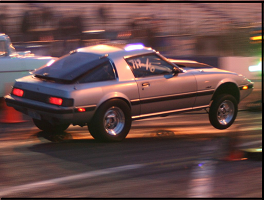



One of the bottom-line requirements of any stick shift drag racing clutch- it must have at least enough clamp pressure to keep from blowing thru the clutch after the shift into hi-gear. That's the point in the run where the clutch sees its maximum load. What many don't realize is that any clutch clamp pressure beyond what's required to hold high gear is actually counter-productive.
There's a big inertia energy release that must go somewhere quick when the engine gets pulled down by the clutch. If the clutch pulls the engine down too fast, that inertia energy exiting the engine's rotating assy will hit the drivetrain with excessive impact, which in-turn leads to spin/bog/broken parts problems during launch. After the shifts, the clutch pulling the engine down too fast can knock the tires loose or reduce the engine's recovery rpm. Managing the rate that rotating assy inertia energy hits the drivetrain is the key to putting it to work as efficiently as possible, and you do that by adjusting the clutch tune.
Since there is more than one way to set up an adjustable clutch, the question here is- "Counterweight or No Counterweight?"
For the purpose of this discussion, let's suppose a minimum of 2200lbs of clutch clamp pressure is required to hold a naturally aspirated engine's output as it falls back to 6000rpm after the hi-gear shift. Below are examples of two different ways to get that 2200lbs of clutch clamp @ 6000rpm out of the same adjustable clutch. Nice round calculated numbers that do not account for pressure creep due to centrifugally induced parts deflection, just to make the critical differences easier to grasp...
Example 1- adjustable clutch with a typical "counterweight" clutch tune- let's set this centrifugal assist clutch up with 900lbs of static clamp pressure. With 900lbs of static, it would need an additional 1600lbs of centrifugal assist by 6000rpm in order to achieve the 2200lbs of clutch clamp required to hold the above engine @ 6000rpm (maximum torque). Basically, 900 static + 1300 centrifugal @ 6000 = 2200lbs @ 6000. While the 900lbs of static clamp pressure will stay the same as rpm climbs, you must keep in mind that the amount of centrifugal assist will exponentially increase as the engine gains rpm. The centrifugal assist contribution of 1300lbs @ 6000 will grow to 2311lbs @ 8000 shift point. That 2311ftlbs of centrifugal, combined with the 900lbs of static, equals a total of 3211lbs of clamp @ 8000rpm. That's over a thousand pounds of excess clutch clamp pressure at the shift point.
Example 2- adjustable clutch with an externally controlled "no-counterweight" clutch tune- let's remove all the counterweight from the levers, and then increase the static clamp pressure enough to achieve 2200lbs of clamp @ 6000rpm. First you must consider that Soft-Lok levers, even without any additional weight, still add around 524lbs of centrifugal assist @ 6000rpm. That means you would only need 1676lbs of static clamp to get the required 2200lbs of overall clamp by 6000rpm. By the 8000rpm shift point, the levers by themselves, even without any weights, will still add another 408lbs of centrifugally induced clamp, bringing the total clamp at the 8000rpm shift point to 2608lbs. That's 408lbs of excess clutch clamp pressure at the shift point.
To sum up the above...
In the past, "no-counterweight" clutch tunes were at a huge dis-advantage overall because they were very hard to launch efficiently. The results were hit and miss, with far more misses than hits. Very low launch rpm helped with consistency, but low launch rpm hurt the engine's ability to produce power.
That "no-counterweight" launch dis-advantage disappears completely when you add one of my ClutchTamer or Hitmaster 2-stage systems to the mix. They give you the ability to adjust the clutch's inertia draw rate during launch externally, independent of engine rpm. With the ability to adjust inertia energy draw rate during launch independent of rpm, the "no-counterweight" clutch tune becomes the winner with its ability to get the job done with more efficiency.
Advantages of the externally controlled "no-counterweight" adjustable clutch tune over the old "counterweight" adjustable clutch tune...
Obviously there is a point with the hi-horsepower engines we have today where static clutch clamp pressure alone may not be enough to hold the power, as the clutch pedal itself may become too stiff to operate with consistency. Those applications may require adding some centrifugal assist, along with lower launch rpm, to reduce clutch pedal effort.
In my opinion for the typical application below about 1200hp, the old counterweight clutch setup has become outdated tech.
Grant
...the "counterweight" clutch tune with the required 2200lbs @ 6k ends up with 1011lbs of excess clamp pressure at the 8k shift point.
...the "no-counterweight" clutch tune with the required 2200lbs @ 6k ends up with only 408lbs of excess clutch clamp pressure at the 8k shift point.
...higher usable launch rpm allows you to store more inertia energy prior to launch that you can then put to work after the clocks start ticking.
...higher launch rpm as well as improved recovery after the shifts raises the engine's average HP output.
...less clamp pressure at the shift point minimizes inertia induced wheelspeed spikes which improves traction.
...less clamp pressure at the shift point reduces clutch induced impact on drivetrain components after the shift.
...makes dead hook launches possible without bogging, makes it easier to take advantage of more efficient radial tires.
...improved consistency. Tune the clutch to dead hook on poor surfaces, no need to change settings when the surface improves.
...eliminates the hassle of switching between street and race clutch settings for street/strip cars.


CHANGING THE GAME ON LAUNCHING YOUR STICK SHIFT CAR!!!